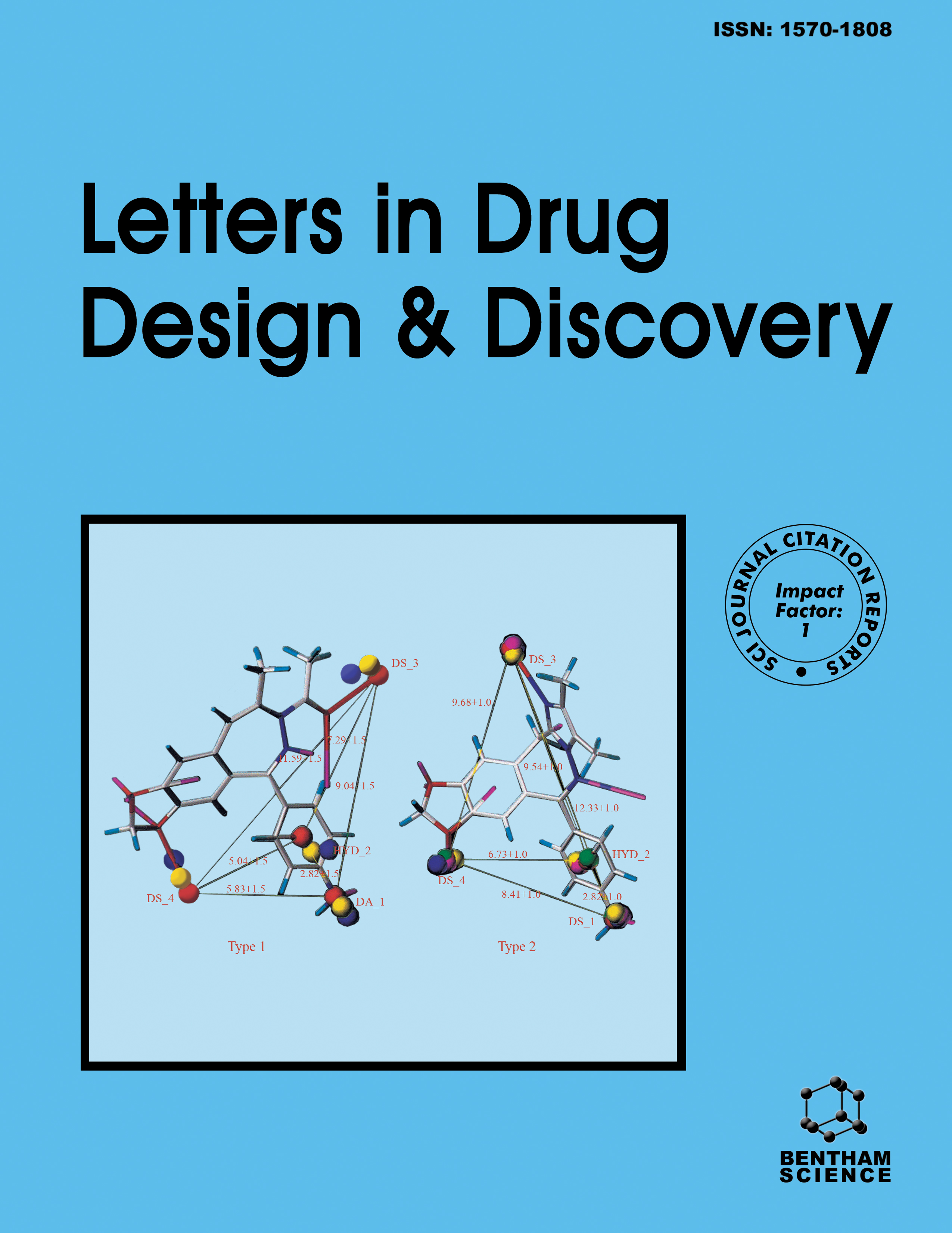- Home
- A-Z Publications
- Letters in Drug Design & Discovery
- Previous Issues
- Volume 20, Issue 4, 2023
Letters in Drug Design & Discovery - Volume 20, Issue 4, 2023
Volume 20, Issue 4, 2023
-
-
Plant Secondary Metabolites as Apoptosis-inducing Agents
More LessBy Uzma FaridiApoptosis or programmed cell death is a carefully synchronized collapse of cells due to protein degradation and fragmentation of DNA. It is an essential part of the life cycle of every multicellular organism, including worms to humans. Apoptosis plays a major role in cancer development as well. Various studies confirm the potential of many drugs to change the regulation and ratio of pro-apoptotic and antiapoptotic factors. Read More
-
-
-
The Role of Aquatic Plants in Natural Products and Drug Discovery
More LessAuthors: Surjeet Verma, Motebang D.V. Nakin, Zesipho Makhosayafana and Namrita LallBackground: Phytochemicals and their derivatives/analogues represent over 50% of the current medicines worldwide in clinical use. Despite a significant contribution to the total bioactive natural plant products, aquatic plants are underestimated, and several species are extinct and in the endangered list. Objective: The aim of this review article is to draw the attention of common people and scientists toward a few importa Read More
-
-
-
A Review on Traditional Anti-ulcer Medicinal Plants
More LessTraditional remedies have been used for generations to treat and maintain people's health and indigenous medicinal plants are an important part of this system, which, unlike western medicine, provide cures for practically all illnesses with no side effects. Ulcer is a chronic ailment that affects most of the world's population and has no absolute cure. An ulcer is the erosion of mucous lining in the gastrointestinal tract due to over Read More
-
-
-
Antimicrobials from Medicinal Plants: Key Examples, Success Stories and Prospects in Tackling Antibiotic Resistance
More LessAuthors: Pragya Tiwari, Mangalam Bajpai and Abhishek SharmaThe rising statistics of antimicrobial resistance pose an alarming concern for the mankind. The extensive/injudicious use of antibiotics in the environment, animal husbandry, and health care have led to the alarming rise of infectious microbes developing resistance against conventional drugs. The use of phytotherapeutics defines an attractive approach to tackling drug-resistant microbes, attributed to their ability to targ Read More
-
-
-
Anti-cancer Potential of Pleurotus Mushroom: Detailed Insight on the Potential Bioactive Molecules, In vitro-In vivo Studies, and Formulation
More LessAuthors: Singh Shreya, Shreyans K. Jain, Santosh K. Guru and Alakh N. SahuEarly mushrooms were categorized under functional food/ nutritional food. However, later on, an increasing number of scientific studies strongly support their role in disease prevention and suppression or remission of a diseased state. Mycotherapy of cancer, a new promising field, deals with anticancerogenic agents derived from mushrooms. Rich in nutritive value, undemanding cultivation conditions, and an army of health-pr Read More
-
-
-
Angiotensin-Converting Enzyme Inhibition Properties and Antioxidant Effects of Plants and their Bioactive Compounds as Cardioprotective Agent
More LessAuthors: Sonal Prasad and Tabish QidwaiBackground: The prevalence of cardiovascular diseases is being increased; researchers are trying to explore effective preventive and treatment options. Antioxidant effects and Angiotensin- Converting. Enzyme (ACE) inhibitors demonstrated cardioprotective effects. Many herbs and plants have shown antiinflammatory, antioxidant, free radical scavenging, and ACE inhibition properties in preventing and treating cardiac-rela Read More
-
-
-
Synergy Potential of Ursolic Acid-Based Hybrid Molecules
More LessBackground: Ursolic acid (UA, 3β-hydroxy-urs-12-en-28-oic acid), a pentacyclic triterpenoid from various medicinal plants, has been blessed with proven biological effects, including antiinflammatory, anticancer, antidiabetic, antioxidant and antibacterial, but its bioavailability and solubility limit its clinical application. Objective: Synthesis of UA-based hybrid molecules to explore their antibacterial and synergy potential in combinat Read More
-
-
-
In Vitro and In Silico Studies of Glycyrrhetinic Acid Derivatives as Antitubercular Agents
More LessBackground: Glycyrrhetinic acid (GA) is a biologically active triterpenoid acid, isolated from the root of the Glycyrrhiza plant species. In our earlier studies, the semisynthetic analogs of GA have been reported to possess improved anticancer activities against various cell lines, antimalarial, and antifilarial activities. Objective: Synthesis of novel C-3 aryl ester derivatives and evaluation of antitubercular activity in order to study str Read More
-
-
-
New 4-nitro-imidazole-N-glycinyl-hydrazones Designed as Trypanocidal Analogues of Benznidazole
More LessBackground: The drugs available for the treatment of Chagas disease are ineffective in its chronic phase and produce many adverse effects, making the search for new drugs an urgent medical need. Objective: This study aimed to design, synthesize, and evaluate the trypanocidal and cytotoxic profiles of new 4-nitroimidazole prototypes. Methods: The new compounds were synthesized in overall yields ranging from 31-t Read More
-
Volumes & issues
-
Volume 21 (2024)
-
Volume 20 (2023)
-
Volume 19 (2022)
-
Volume 18 (2021)
-
Volume 17 (2020)
-
Volume 16 (2019)
-
Volume 15 (2018)
-
Volume 14 (2017)
-
Volume 13 (2016)
-
Volume 12 (2015)
-
Volume 11 (2014)
-
Volume 10 (2013)
-
Volume 9 (2012)
-
Volume 8 (2011)
-
Volume 7 (2010)
-
Volume 6 (2009)
-
Volume 5 (2008)
-
Volume 4 (2007)
-
Volume 3 (2006)
-
Volume 2 (2005)
-
Volume 1 (2004)
Most Read This Month
Article
content/journals/lddd
Journal
10
5
false
en


